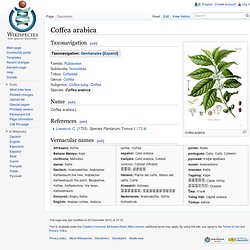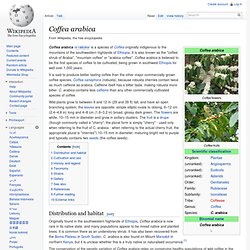

Coffee bean. The appearance of unroasted, green coffee seeds.

Roasted coffee seeds. A coffee bean is a seed of the coffee plant, and is the source for coffee. It is the pit inside the red or purple fruit often referred to as a cherry. Even though they are seeds, they are incorrectly referred to as 'beans' because of their resemblance to true beans. The fruits - coffee cherries or coffee berries - most commonly contain two stones with their flat sides together. Origin[edit] Coffee berries The Americas were first introduced to the plants around 1723. South America is now responsible for approximately 45% of the world's total coffee exports.
Significant dates[edit] Etymology[edit] Coffee plant[edit] The coffee tree averages from 5–10 m (16–33 ft) in height. Coffee plants are grown in rows several feet apart. Processing[edit] When the fruit is ripe, it is almost always handpicked, using either "selective picking", where only the ripe fruit is removed. There are two methods of processing the coffee berries. Coffee. Coffee is a brewed beverage prepared from the roasted or baked seeds of several species of an evergreen shrub of the genus Coffea.

The two most common sources of coffee beans are the highly regarded Coffea arabica, and the "robusta" form of the hardier Coffea canephora. The latter is resistant to the coffee leaf rust (Hemileia vastatrix), but has a more bitter taste. Coffee plants are cultivated in more than 70 countries, primarily in equatorial Latin America, Southeast Asia, and Africa. Once ripe, coffee "berries" are picked, processed and dried to yield the seeds inside. The seeds are then roasted to varying degrees, depending on the desired flavor, before being ground and brewed to create coffee. Coffee is slightly acidic (pH 5.0–5.1[1]) and can have a stimulating effect on humans because of its caffeine content. Etymology[edit] The first reference to coffee in the English language is in the form chaoua, dated to 1598.
History[edit] Legendary accounts[edit] Historical transmission[edit] Coffea arabica. Coffea arabica [edit] Familia: Rubiaceae Subfamilia: Ixoroideae Tribus: Coffeeae Genus: Coffea Subgenus: Coffea subg.

Coffea Species: Coffea arabica Name[edit] Coffea arabica L. References[edit] Linnaeus, C. (1753). Vernacular names[edit] Afrikaans: KoffieBahasa Melayu: KopichiShona: Muhubvadansk: KaffeDeutsch: Arabicakaffee, Arabischer Kaffeebaum the tree, Arabischer Kaffeestrauch the plant, Bergkaffee, Kaffee, Kaffeebohne, the bean, KaffeestrauchΕλληνικά: Καφές KafesEnglish: Arabian coffee, Arabica coffee, Coffeeespañol: Café arábicafrançais: Café arabica, Caféier commun, Caféier d'Arabie한국어: 커피나무italiano: Pianta del caffè, Albero del caffè, CaffèKiswahili: Kahawaമലയാളം: കാപ്പിചെടിNederlands: Arabicakoffie, Koffie, Koffiestruikpolski: Kawaportuguês: Cafe, Café, Caféeiroрусский: Кофе арабикаsuomi: Arabiankahvisvenska: KaffeTagalog: Kapéதமிழ்: Capie cottayతెలుగు: Chaabeไทย: กาแฟTiếng Việt: Càphê arabicaTürkçe: Kahve.
Coffea arabica. Coffea arabica /əˈræbɪkə/ is a species of Coffea originally indigenous to the mountains of the southwestern highlands of Ethiopia.

It is also known as the "coffee shrub of Arabia", "mountain coffee" or "arabica coffee". Coffea arabica is believed to be the first species of coffee to be cultivated, being grown in southwest Ethiopia for well over 1,000 years. It is said to produce better tasting coffee than the other major commercially grown coffee species, Coffea canephora (robusta), because robusta cherries contain twice as much caffeine as arabica.
Caffeine itself has a bitter taste, making robusta more bitter. C. arabica contains less caffeine than any other commercially cultivated species of coffee. Wild plants grow to between 9 and 12 m (29 and 39 ft) tall, and have an open branching system; the leaves are opposite, simple elliptic-ovate to oblong, 6–12 cm (2.4–4.8 in) long and 4–8 cm (1.6–3.2 in) broad, glossy dark green. Distribution and habitat[edit] Cultivation and use[edit]